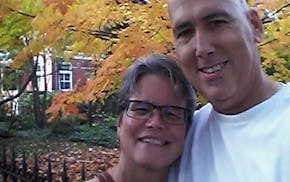The judge was deliberate and solemn, choosing to write and read his decision carefully instead of speaking extemporaneously. It was what the moment demanded.
After all, to District Judge Joseph F. Chase, it was the culmination of something ominous and nearly incomprehensible: "That day, Waseca was spared."
Chase was the judge charged with sentencing in the case of John David LaDue, the teen who became a student of mass killers and then conceived a plot to murder his own family and classmates. In his sentence, Chase acknowledged the horror and pain LaDue caused the community, his family, his friends. As Chase quoted Waseca Schools Superintendent Tom Lee, the plan was "the scab over the wound of fear and anxiety" that plagued the city.
But he also could not help but mention Waseca's extreme fortune, tailored to a nondenominational audience.
"Call it what you will — grace, providence, fate, good luck, a guardian angel — tragedy was almost miraculously averted in this town on April 29, 2014," the judge wrote.
A miracle? Good luck? An alert neighbor who recognized something wasn't right when she saw LaDue enter a storage locker?
No one can say for sure. Nor can anyone guarantee that the outcome — years of probation and hopes that treatment will take — will work.
It is difficult to identify just what to take away from this case. There is speculation, there are theories and there are justifications.
"I am most comfortable in my thinking when I can see crime in black and white terms — when the offender is plainly morally blameworthy and therefore obviously and justly subject to condemnation and punishment," Chase wrote. "This case is more complicated."
Indeed.
LaDue, according to experts, has Autism Spectrum Disorder (ASD). He lacks empathy and has a fixation on violence, which is atypical even for people with ASD. "He is not at fault for having this condition any more than one can be at fault for having diabetes or asthma," the judge wrote.
Yet, that does not take away the fear his behavior caused. In a fascinating piece in the Oct. 19 New Yorker, Malcolm Gladwell offered up a theory, albeit a highly speculative one, about what may drive people like LaDue.
"LaDue is a scholar of the genre, who speaks of his influences the way a budding filmmaker might talk about Fellini or Bergman," wrote Gladwell. "He had planned every aspect of the attack meticulously, except for the part where he actually launches the attack."
Did the fact that LaDue had not yet carried out the plan mean he wouldn't? No one knows.
Dawn Johnson, LaDue's public defender, said Monday that she appreciated Gladwell's focus on police questions to her client about why he had not followed through. "They highlight how John never gave a valid reason for why he did not execute his plan in April, as he had outlined in his journal," Johnson said. "This calls into question whether he ever really intended to go through with it."
Gladwell coined the term "tipping point" and seems keen to find essential moments in contemporary society. He wrote that the best explanation for LaDue's behavior might be found in sociological theories about why people riot, and suggested that such people not be studied individually, but as a "group phenomenon."
Gladwell took the work of Stanford sociologist Mark Granovetter and applied it to people like LaDue: "A riot was a social process, in which people did things in reaction to and in combination with those around them. Social processes are driven by our thresholds — which he defined as the number of people who need to be doing some activity before we agree to join them."
LaDue had studied his predecessors, copied them and even judged them. He didn't like the "cowards" who shot themselves when police arrived. He disliked Sandy Hook shooter Adam Lanza because he shot kindergartners. Instead, he idolized Columbine killer Eric Harris: "I think I just see myself in him," LaDue told police.
"In the world before Columbine, people like LaDue played with chemistry sets in their basements and dreamed of being astronauts," Gladwell wrote. "He wasn't violent or mentally ill. His problem was something far more benign. He was simply a little off."
But what do we do with those people, people who are a little off, who may or may not carry out their fantasies? For those who agreed to probation and treatment for LaDue, Gladwell's conclusion may not be very comforting.
"The problem is not that there is an endless supply of deeply disturbed young men who are willing to contemplate horrific acts," he wrote. "It's worse. It's that young men no longer need to be deeply disturbed to contemplate horrific acts."
LaDue's lawyer, Johnson, said that community reaction has been varied. "Some have commented to me that they are grateful that John was able to receive the psychological intervention and treatment that he needed. Others think John got off scot-free."
Johnson feels LaDue was "horribly overcharged," and that he will take to treatment. "He has been nothing but a model inmate at all three facilities, and I think that shows promise for his ability to successfully complete probation," she said.
Judge Chase faced a horrible challenge, most likely the most difficult in his career. He did what he could, and took the advice of professionals. Should LaDue ever return to the community, Chase urged people not to shun him, to bring him "into the light of day" and force association with others.
Yet, Chase recognized that would be difficult. "The natural reaction would be to push Mr. LaDue away, for community members to have as little to do with him as possible," he wrote. "We're only human."
jtevlin@startribune.com • 612-673-1702
Follow Jon on Twitter: @jontevlin

Tevlin: 'Against all odds, I survived a career in journalism'

Tevlin: Grateful Frogtown couple fight their way back from fire and illness




